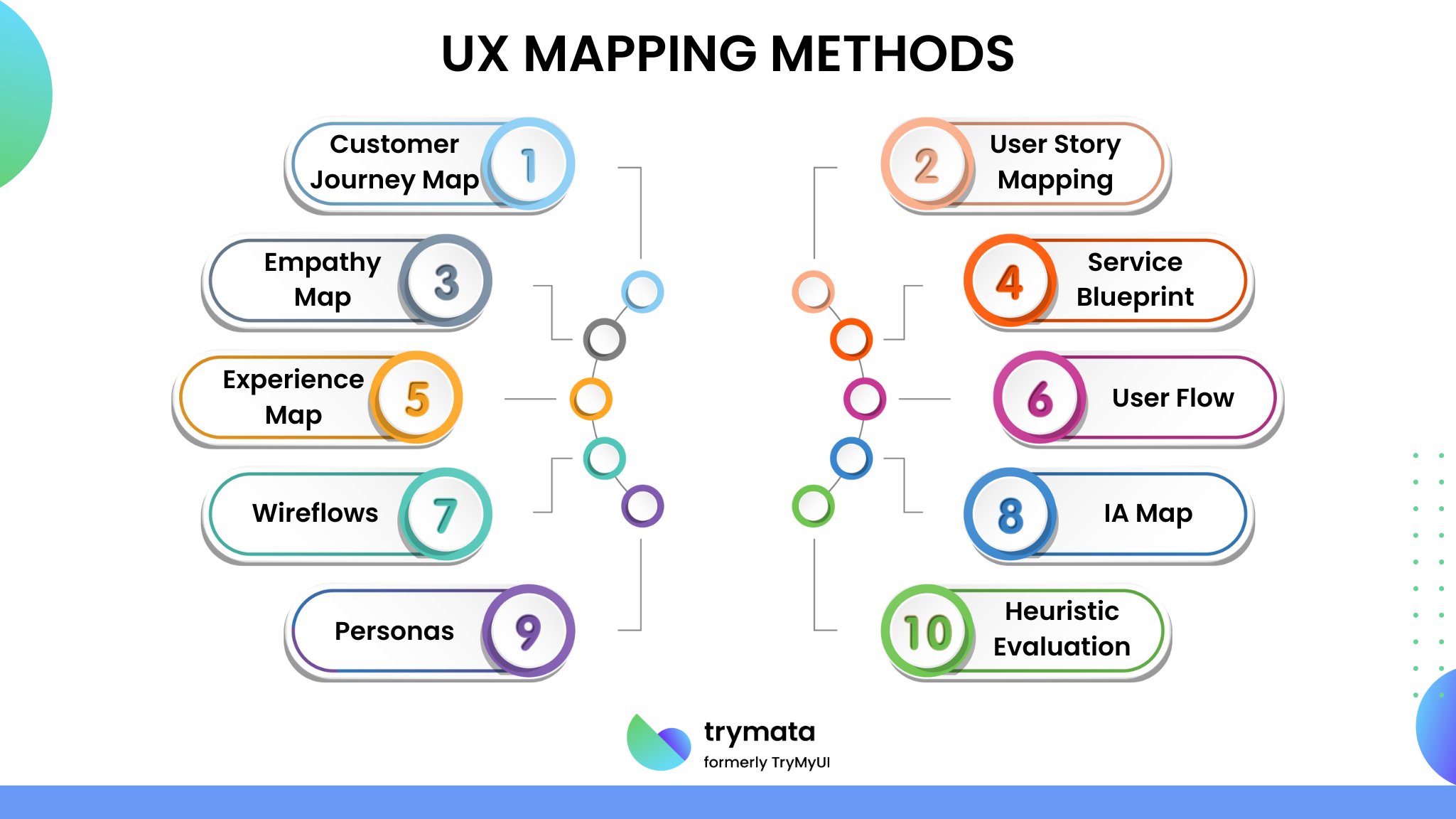Delivering an exceptional user experience is paramount. UX mapping methods are powerful tools that help designers and teams visualize and understand the journey users take with a product or service. But what exactly is UX mapping, and why is it so crucial?
UX mapping visualizes the user’s interactions, emotions, and touchpoints throughout their journey. These maps reveal the intricacies of user experience, from initial contact to post-purchase, highlighting pain points and opportunities for improvement. Teams can gain deep insights into user needs and behaviors by employing various UX mapping methods, such as customer journey maps and empathy maps.
This blog explores the essentials of UX mapping methods. It offers a comprehensive look at what UX mapping entails, its significance, different types of maps, and best practices for creating effective and insightful maps.
What Is UX Mapping?
UX Mapping, or User Experience Mapping, is a technique used to visually represent the various stages, touchpoints, emotions, and actions a user experiences while interacting with a product, service, or brand. UX mapping aims to understand the user’s journey better, identify pain points, and uncover opportunities to improve the user experience.
UX maps take various forms, depending on what aspect of the user experience you want to analyze. Common types of UX maps include customer journey maps, empathy maps, user story maps, and service blueprints. Each of these maps focuses on different facets of the user’s interaction with a product or service, from emotional responses to the steps a user takes to achieve a goal.
Why Is UX Mapping Important?
UX mapping is crucial because it brings the user’s experience to the forefront of the design process. It helps teams:
- Understand User Needs: By mapping out the user journey, designers can identify what users need at each stage of their interaction with a product.
- Identify Pain Points: UX maps highlight areas where users may struggle, allowing teams to address these issues proactively.
- Enhance Collaboration: Visual maps are a common reference point for all team members, from designers to developers, fostering better communication and collaboration.
- Improve Decision-Making: With a clear understanding of the user experience, teams can make informed decisions that enhance usability and satisfaction.
- Drive Innovation: By visualizing the entire user journey, teams can spot opportunities for innovation and differentiation.
UX Mapping Methods
Several UX mapping methods serve a unique purpose and provide different insights into the user experience. Below are some of the most commonly used methods:

1. Customer Journey Map
A Customer Journey Map visually represents the user’s steps while interacting with a product or service. It captures the user’s actions, thoughts, and emotions throughout their journey, from initial awareness to post-purchase. This map helps identify key touchpoints and pain points, allowing a deeper understanding of the user’s experience.
2. User Story Mapping
User Story Mapping is a method for visualizing and prioritizing features or tasks based on the user’s journey. It involves breaking down the user’s journey into a series of stories or tasks, which are then organized into a map. This method benefits teams working in Agile environments, as it helps prioritize features that deliver the most value to the user.
3. Empathy Map
An Empathy Map is a tool that helps teams understand the user’s emotions, thoughts, and behaviors. It is divided into four quadrants: what the user says, thinks, does, and feels. Empathy maps help teams design products that resonate with users on a deeper level by focusing on the user’s perspective.
4. Service Blueprint
A Service Blueprint is a detailed map that outlines the entire service process, including both the frontstage (customer-facing) and backstage (internal) activities. This map is useful for understanding the complexities of service delivery and ensuring that all service elements align with the user’s needs and expectations.
5. Experience Map
An Experience Map provides a broad overview of the user’s experience across different touchpoints and channels. It captures the user’s journey, highlighting key interactions and emotional responses. Experience maps are valuable for understanding how users engage with a brand across multiple channels and identifying areas for improvement.
6. User Flow
User Flow maps a user’s path through a product or service to achieve a specific goal. It outlines each user journey step, including decision points and possible pathways. User flows help ensure that the product is designed to be intuitive and that users can easily accomplish their goals.
7. Wireflows
Wireflows combine wireframes, and user flows to visualize the user’s interaction with an interface at each step. They are handy for designing and refining the structure and flow of an interface, ensuring that each interaction is seamless and aligned with user expectations.
8. Information Architecture (IA) Map
An Information Architecture Map organizes and labels the content and structure of a website or application. It helps create an intuitive navigation system that allows users to find information quickly. IA maps are essential for ensuring the product’s content is well-organized and accessible.
9. Personas
Personas are fictional characters representing users who might use a product or service. They help teams design with specific user needs, goals, and behaviors in mind. By creating detailed personas, teams can ensure that the product resonates with its target audience.
10. Heuristic Evaluation
A Heuristic Evaluation is a usability inspection method where evaluators assess the interface based on established usability principles (heuristics). This method helps identify usability issues that need to be identified through other mapping techniques.
How to Create a UX Map
Creating a UX map involves several key steps to ensure it accurately reflects the user’s journey and provides actionable insights. Here’s a streamlined process to guide you:
- Define Objectives: Start by clarifying the goals of your UX map. Are you focusing on the customer journey, a specific interaction, or a particular pain point? Establishing clear objectives will help guide the mapping process.
- Gather Data: Collect qualitative and quantitative data about your users. This can include user interviews, surveys, analytics, and usability testing. Understanding user behaviors, needs, and pain points is crucial for creating an accurate map.
- Identify User Personas: Define the user personas represented on the map. Personas are fictional characters that embody the key characteristics of your target users. They help frame the map within the context of user needs and goals.
- Outline Key Stages: Break down the user journey into distinct stages or phases. For example, in a customer journey map, these could be awareness, consideration, purchase, and post-purchase.
- Map User Actions and Emotions: For each stage, document the user’s actions, thoughts, and emotions. Identify touchpoints and interactions the user has with the product or service. Capture their emotional responses and any pain points or challenges they encounter.
- Visualize the Map: Create a visual representation of the journey. Use diagrams, flowcharts, or other visual tools to lay out the stages, actions, emotions, and touchpoints. Ensure the map is easy to understand and effectively communicates the user experience.
- Review and Refine: Share the map with stakeholders and gather feedback. Use their insights to refine the map and address any gaps or inaccuracies. Regularly update the map based on new data or changes in the user experience.
This process helps create a comprehensive UX map that provides valuable insights into user interactions and informs better design decisions.
UX Mapping Best Practices
To maximize the effectiveness of UX mapping, adhere to the following best practices:
1. Involve Cross-Functional Teams
Engage stakeholders from various departments, such as design, development, marketing, and customer service. This collaborative approach ensures that the map reflects a comprehensive view of the user experience and aligns with business goals.
2. Use Real User Data
Base your maps on user research rather than assumptions. Gather data from user interviews, surveys, analytics, and usability testing to ensure the insights are accurate and actionable.
3. Define Clear Objectives
Clearly outline the goals of your UX map. Whether focusing on the overall customer journey, a specific touchpoint, or user emotions, having a defined purpose helps guide the mapping process and ensures the results are relevant.
4. Keep the User at the Center
Always prioritize the user’s perspective. Focus on their needs, goals, and pain points to create maps reflecting their experience. This user-centered approach helps in designing solutions that resonate with real user challenges.
5. Visualize Clearly
Ensure that your UX maps are clear and easy to understand. Effectively represent stages, actions, emotions, and touchpoints with diagrams, flowcharts, or other visual tools. Good visualization helps communicate insights to all team members.
6. Iterate Regularly
UX mapping is not a one-time activity. Update and refine your maps regularly based on new data, feedback, and changes in the user experience. Iteration helps keep the map relevant and aligned with evolving user needs.
7. Document Insights and Actions
Document key insights and recommended actions alongside the map. This will facilitate translating the findings into actionable design improvements and ensure that the map leads to tangible results.
By following these best practices, you can create UX maps that provide valuable insights, foster team alignment, and drive meaningful improvements in the user experience.
Conclusion
UX mapping methods are essential tools for understanding and improving the user experience. By visualizing the user journey, teams can identify pain points, optimize processes, and create more user-centered designs.
When mapping a customer journey or evaluating a user flow, following the proper steps and best practices will ensure that your UX maps are practical and actionable.
Whether you’re a designer, developer, or product manager, understanding and utilizing these methods can significantly enhance your ability to create user-centered solutions that resonate with your audience.
Investing time in UX mapping can better align your design and development efforts with your users’ needs and expectations, ultimately leading to a more satisfying and successful product.
What is a UX Audit? Definition, Methods, Example and Process




